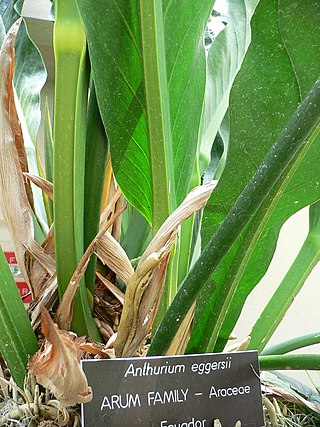
Xanthosoma is a genus of flowering plants in the arum family, Araceae. The genus is native to tropical America but widely cultivated and naturalized in other tropical regions. Several are grown for their starchy corms, an important food staple of tropical regions, known variously as malanga, otoy, otoe, cocoyam, tannia, tannier, yautía, macabo, ocumo, macal, taioba, dasheen, quequisque, ʻape and as Singapore taro. Many other species, including especially Xanthosoma roseum, are used as ornamental plants; in popular horticultural literature these species may be known as ‘ape due to resemblance to the true Polynesian ʻape, Alocasia macrorrhizos, or as elephant ear from visual resemblance of the leaf to an elephant's ear. Sometimes the latter name is also applied to members in the closely related genera Caladium, Colocasia (taro), and Alocasia.

Combretum padoides, the thicket bushwillow, occurs in the lowlands of tropical and south-eastern Africa. They grow in a range of habitats from muddy riverbanks to dry rocky hillsides. The mostly opposite oval leaves are carried on long slender branches. The trees or shrubs flower in profusion in mid-summer and the 4-winged fruits reach maturity from late summer to mid winter.
Baccharis eggersii is a species of flowering plant in the family Asteraceae that is endemic to Ecuador. Its natural habitat is subtropical or tropical dry forests. It is threatened by habitat loss. It may occur in Churute Mangroves Ecological Reserve and Machalilla National Park.
Critonia eggersii is a species of flowering plant in the family Asteraceae. It is found in Ecuador. Its natural habitat is subtropical or tropical moist lowland forests. It is threatened by habitat loss.
Lycoseris eggersii is a species of flowering plant in the family Asteraceae. It is found only in Ecuador. Its natural habitats are subtropical or tropical moist lowland forests and subtropical or tropical moist montane forests. It is threatened by habitat loss.
Afrothismia winkleri is a species of plant in the Burmanniaceae family. It is found in Cameroon, Nigeria, and possibly Uganda. Its natural habitat is subtropical or tropical moist lowland forests. It is threatened by habitat loss.
Amorphophallus preussii is a species of plant in the family Araceae. It is endemic to Cameroon. Its natural habitats are lowland tropical and subtropical moist broadleaf forests and subtropical and montane tropical and subtropical coniferous forests. It is a Vulnerable species threatened by habitat loss.

Anthurium eggersii is a species of plant in the family Araceae. It is endemic to Ecuador. Its natural habitat is subtropical or tropical moist lowland forests. It is threatened by habitat loss.
Anthurium gualeanum is a species of plant in the family Araceae. It is endemic to Ecuador. Its natural habitats are subtropical or tropical moist lowland forests and subtropical or tropical moist montane forests. It is threatened by habitat loss.
Anthurium pallatangense is a species of plant in the family Araceae. It is endemic to Ecuador. Its natural habitat is subtropical or tropical moist montane forests. It is threatened by habitat loss.
Anthurium pallidiflorum is a species of plant in the family Araceae. It is endemic to Ecuador. Its natural habitat is subtropical or tropical moist lowland forests. It is threatened by habitat loss.
Anthurium rigidifolium is a species of plant in the family Araceae. It is endemic to Ecuador. Its natural habitat is subtropical or tropical moist montane forests. It is threatened by habitat loss.
Magnistipula conrauana is a species of plant in the family Chrysobalanaceae. It is endemic to Cameroon. Its natural habitats are subtropical or tropical moist lowland forests and subtropical or tropical moist montane forests. It is threatened by habitat loss.
Maytenus eggersii is a species of plant in the family Celastraceae. It is a tree endemic to Ecuador. It is threatened by habitat loss.
Psilanthele is a genus of plants in the family Acanthaceae, subfamily Acanthoideae, tribe Justicieae. The genus contains only one species, Psilanthele eggersii, native to Ecuador. Its habitat is coastal forest up to an elevation of 530 m. It assessed in 2003 as "critically endangered".
Trichoscypha bijuga is a species of plant in the family Anacardiaceae. It is found in Cameroon, Ivory Coast, Equatorial Guinea, Ghana, Guinea, and Liberia. Its natural habitat is subtropical or tropical moist lowland forests. It is threatened by habitat loss.
Uvariastrum zenkeri is a species of plant in the Annonaceae family. It is found in Cameroon and Nigeria. It is threatened by habitat loss.
Xanthosoma weeksii is a species of plant in the family Araceae. It is endemic to Ecuador. Its natural habitat is subtropical or tropical moist montane forests. It is threatened by habitat loss.
Gymnosiphon usambaricus is a species in the plant family Burmanniaceae. It is endangered due to habitat loss with an estimated 2500 mature individuals left. It is native to Kenya and Tanzania, and is found in the leaf litter in evergreen forests.
Xanthosoma hylaeae is a species of flowering plant in the family Araceae, native to western South America and northern Brazil. A night-bloomer, it uses a variety of scents to attract its pollinators, scarab beetles in the tribe Cyclocephalini.



